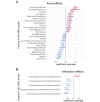Factors Associated With Psychological Disturbances During the COVID-19 Pandemic: Multicountry Online Study
- PMID: 34254939
- PMCID: PMC8396308
- DOI: 10.2196/28736
Factors Associated With Psychological Disturbances During the COVID-19 Pandemic: Multicountry Online Study
Abstract
Background: Accumulating evidence suggests that the COVID-19 pandemic has negatively impacted the mental health of individuals. However, the susceptibility of individuals to be impacted by the pandemic is variable, suggesting potential influences of specific factors related to participants' demographics, attitudes, and practices.
Objective: We aimed to identify the factors associated with psychological symptoms related to the effects of the first wave of the pandemic in a multicountry cohort of internet users.
Methods: This study anonymously screened 13,332 internet users worldwide for acute psychological symptoms related to the COVID-19 pandemic from March 29 to April 14, 2020, during the first wave of the pandemic amidst strict lockdown conditions. A total of 12,817 responses were considered valid. Moreover, 1077 participants from Europe were screened a second time from May 15 to May 30, 2020, to ascertain the presence of psychological effects after the ease down of restrictions.
Results: Female gender, pre-existing psychiatric conditions, and prior exposure to trauma were identified as notable factors associated with increased psychological symptoms during the first wave of COVID-19 (P<.001). The same factors, in addition to being related to someone who died due to COVID-19 and using social media more than usual, were associated with persistence of psychological disturbances in the limited second assessment of European participants after the restrictions had relatively eased (P<.001). Optimism, ability to share concerns with family and friends like usual, positive prediction about COVID-19, and daily exercise were related to fewer psychological symptoms in both assessments (P<.001).
Conclusions: This study highlights the significant impact of the COVID-19 pandemic at the worldwide level on the mental health of internet users and elucidates prominent associations with their demographics, history of psychiatric disease risk factors, household conditions, certain personality traits, and attitudes toward COVID-19.
Keywords: COVID-19; depression; general psychological disturbance; global; mental health; pandemic; posttraumatic stress disorder.
©Martyna Plomecka, Susanna Gobbi, Rachael Neckels, Piotr Radzinski, Beata Skorko, Samuel Lazzeri, Kristina Almazidou, Alisa Dedic, Asja Bakalovic, Lejla Hrustic, Zainab Ashraf, Sarvin Es Haghi, Luis Rodriguez-Pino, Verena Waller, Hafsa Jabeen, A Beyza Alp, Mehdi Behnam, Dana Shibli, Zofia Baranczuk-Turska, Ali Jawaid, Salah Qureshi, Adriana M Strutt, Ali Jawaid. Originally published in JMIR Mental Health (https://mental.jmir.org), 19.08.2021.
Conflict of interest statement
Conflicts of Interest: None declared.
Figures




References
-
- Coronavirus disease 2019 (COVID-19) Situation Report – 90. World Health Organization. [2021-06-29]. https://www.who.int/docs/default-source/coronaviruse/situation-reports/2....
LinkOut - more resources
Full Text Sources
Miscellaneous

